

Over the next 1000 seconds, during the Nucleosynthesis Era, the predominant process was the production of stable nuclei of hydrogen and helium. Some of the protons (p+) and electrons (e-) that survived initial annihilation combined to produce new neutrons (n) by weak force interactions, which added to the supply of remaining hadronic neutrons. During this stage, thermonuclear fusion commenced, yielding a detonation referred to as the primordial fireball on a grandiose scale that is just hinted at by a hydrogen bomb's explosion. As temperatures dropped below 109 K (at ~ 3 minutes), neutrons captured available protons (hydrogen nuclei) to form deuterium (heavy hydrogen) nuclei; all primordial deuterium (actually, at the time, a deuteron or H2 nucleus) was created in the first minutes of the Big Bang but younger helium is subsequently being both created and destroyed in star fusion (presently, ~1 deuterium atom per 30000 hydrogen atoms is the survival ratio) . Reaction between deuterons and protons can produce helium (He3) ; in turn, two He3 nuclei can combine to form the heavy helium isotope (He4) plus released protons. This brief era witnessed the synthesis of the primordial nuclear constituents -- ~90% hydrogen/deuterium and 10% helium by numbers of particles and 75-25% by mass that make up the two elements subsequently dominating the Universe , along with minute amounts of lithium. Most helium was produced at this early time, but younger helium is also the product of hydrogen burning in stars; the ratio of He/H has remained nearly constant because about as much new He is then created as converted to heavier elements during stellar evolution. The hydrogen nuclei generated in this critical time span later became the basic building material for stars, which are the sites of the internal stellar nucleosynthesis (fusion) that eventually spawned the elements with atomic numbers (symbol = Z, whose value is the unique number of protons in the nucleus of a given element) up to 26 (Fe or iron); these account for the dominant elements, in terms of both mass and frequency, in the Universe (elements with Z > 26 are produced in other ways, as described later).
As the fireball subsided with continuing Universe expansion, the matter produced was dispersed in a still very dense "soup" of predominantly x-ray photon radiation along with neutrinos and nucleons and other elementary particles (a mix of ionized nuclei and free electrons known as a plasma). None of the chemical elements with mass numbers greater than 2 (helium) had come into existence at this stage (they originated later by being synthesized in stars). The time that lasted from after the first fifteen minutes to about 10,000 years (cosmic time, i.e., since the moment of the Big Bang) is known as the Radiation Era (connoting the dominance of electromagnetic radiation) . The Universe during this stage was opaque ("fog") because radiation was prevented from leaving its confines owing to internal scattering by free electrons. As expansion proceeded, the mass-equivalent radiation density (E = mc2 equivalency) decreased as mass density increased (today, mass density greatly exceeds radiation density even though the number of photons [individually, almost massless] is much larger [in a ratio of ~1 billion photons to every baryon]). So, by the first 10,000 years, the Universe had started to become mass-dominated. This radiation era ended with the onset of the Decoupling Era, at which stage cooling had dropped below 3,000 K, allowing protons and helium nuclei to combine with electrons forming hydrogen and helium atoms. As this stage (also known as the Recombination Era) began, the Universe was about 1/200th its present size. The decreased numbers of free electrons reduced scattering to the extent that the opaque Universe now became transparent to radiation (allowed photons to pass through), even as interstellar space, which is a near-vacuum, became black, i.e., does not give off luminous self-radiation but does contain very low densities of photons and other particles (about 3 atoms per cubic meter), and does facilitate free passage within any region of radiation from external sources. This era is estimated to have lasted up to 300,000 years (generally accepted value) to perhaps as long as the first million years.
As the dispersing mix of H and He atoms, photons, and other particles continued
to expand (thereby progressively decreasing in density), it eventually cooled
to temperatures around a few degrees Kelvin. (see Cosmic Background Radiation
on page Cosmo-5). Large-scale variations (called fluctuations or seed perturbations)
in mass and energy density, whose origin can be traced to the early moments
of the Big Bang, occurred at random throughout the enlarging Universe. In regions
of density increase as small as <1%, gravitational forces acting between the
innumerable constituents led to attractions that built up regions marked by
slightly greater concentrations of matter (still mostly hydrogen and helium).
Variations in radiation pressures also contributed to the process, at times
countering the gravity-induced densification. With time, these clots grew more
dense (up to 5% overdense) as they continued to draw in (by attraction) matter
from their surroundings. Many clots eventually collapsed into vast nebulae ("clouds")
from which galaxies were initiated. A galaxy is an organized concentration
or clumping of stars (but individuals still widely separated from one another
by distances measured in tens of light years) in an aggregate containing billions
of discrete stars. Typical maximum dimensions of a galaxy range from 80,000
to 150,000 light years in diameter.
As early as 1 million years (m.y.) (cosmic time; measured from the moment of
the Big Bang) and perhaps as far back as the early Decoupling Era, but especially
in the first billion years, protogalaxies (incipient or first stage galaxies)
began to organize on a grand scale (by a set of processes beyond the scope of
this review). These evolved over time into fullblown galaxies, consisting of
stars (localized spherical clots of gas [initially H and some He] that contract
and heat up to interior temperatures > 106 K, thereby becoming
luminous [radiant] bodies).Amazingly, despite the huge number of stars in a
galaxy, most of space is interstellar and, even more so, intergalactic, with
individual stars in a galaxy being widely separated (a scale analogy: if a star
is represented by a marble just 1 centimeter in diameter, the average distance
to its nearest neighbor stars is around 300 kilometers). All stars together
(totaled for all galaxies) comprise just about 1 part per million of Universal
space: thus in the total volume of observable space, "void" dominates
and luminous objects are an exceedingly small part (far less than one might
expect by looking through a telescope in which much of the field of view seems
occupied by points of light [galaxies or galactic clusters], since there are
huge distances between them in the direction of viewing).
One model ("top down") of early galaxy evolvement considers a cloud
to fragment into star groupings as it develops from hot dark (radiating but
not luminous) gaseous matter. Another galactic model ("bottom up")
begins the process with localized multi-star formation from cold dark (low levels
of EM radiance) matter, with subsequent aggregation into fewer stars that grow
mainly by collision ("cannibalism") with one another. Recent observations
suggest the bottom up model describes the predominant process. Also, other surveys
(especially with the Hubble Space Telescope [see below]) indicate a large number
of individual stars, or small groups, with populations much below that of even
the smaller galaxies, occur dispersed in intergalactic space as well as in the
halo regions above and below the volumes of space containing the bulk of the
stars in the galaxies themselves. Thus, star formation is a general process
(see next page) that can take place wherever widespread to local concentrations
of hydrogen gas produce clouds of matter of sufficient density to initiate gravitational
contractions.
A common type of clustered stars is the spiral galaxy, seen here in
both top and edge views. This type consists of stars arranged in a flattened
disc wherein younger (blue) stars are strung out in several prominent spiraling
arms that emanate from a central nucleus
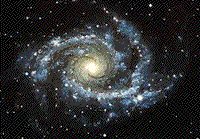 |
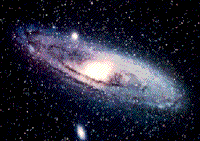 |
comprised of a denser collection of older (yellow to orange) stars. Typical spiral galaxies are about 100,000 light years in diameter; disc thicknesses are less than 10,000 l.y. The disc shape results from a greater degree of collapse in one direction and a significant transfer of angular momentum to the disc arms as a effect of tidal (gravitational) interaction with nearby galaxies (clots of dark matter and some stars exist as a halo above and below the flattened central disc). A second type (left, below), the elliptical galaxy, contains mostly old stars (up to 1012); such a galaxy originates through collisions, tidal disruption and other interactions, often between dwarf or even major spirals. Globular star clusters (right) - each an aggregate of 100,000 to a million stars - are common in elliptical galaxies; Some galaxies - known as dwarf galaxies - contain as few as one hundred million stars. Thus, throughout the Universe the diversity of types and sizes of galaxies is considerable.
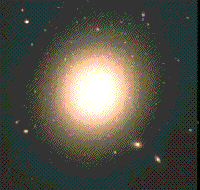 |
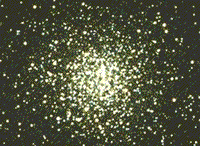 |
Individual galaxies of each type are separated by distances of up to millions
of light years. Despite these large separations, collisions between galaxies
(one tends to "pass" through the other) have been observed and may
well be common. Galaxies tend to be grouped in great clusters or even superclusters
(collections of proximate clusters) arranged commonly in elongated bands or
strings that began aligning about 1-2 billion years after time zero. The elliptical
galaxies are more abundant than spiral in these superclusters. Intergalactic
space between superclusters contains lower numbers of galaxies, in regions the
decrease may be so sharp as to warrant the term "voids". The diagram
below displays the distribution of approximately 2500 bright galaxies within
a 10 Mpc thick wedge of outer space extending out to 300 Megaparsecs (Mpc) over
a declination ranging between 26.5° and 44.5° (a parsec is a distance
measure based on parallax methods; it is ~3.26 light years). This survey is
part of an on-going sky count being made by Margaret Geller and associates of
Harvard's Center for Astrophysics. The plot clearly indicates that many galaxies
organize along distinct linear clusters described as "filaments".
Some volumes of space have low populations of clusters, indicating voids. The
reason for clustering is still uncertain but probably is set up by variations
in matter distribution during the early stages of expansion (perhaps even extending
back to fluctuations during the inflationary period in the early fractions of
the first cosmic second).
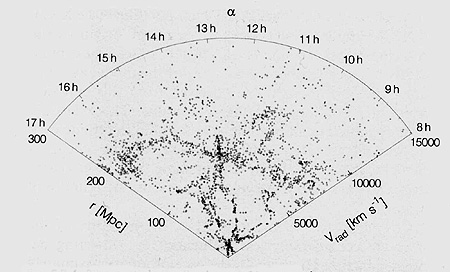
The total number of galaxies spread more or less uniformly across the Universe is not known, with any degree of certainty - no one has yet attempted to count the myriads that appear to exist. Estimates can be made by sampling segments of the observable Universe and then extrapolating throughout the celestial sphere encompassing the Earth. However, be advised that the outer reaches of the observable Universe have yet to be seen, if indeed one can imagine such limits (there is no proof or reasonable assumption that demands the Universe to be bounded or finite). Plausible estimates hold the number of galaxies to be on the order of 100 billion (1011) and the number of stars contained in typical galaxies to be of similar magnitudes (small galaxies with only a few billion stars do exist). Most galaxies are very old (the bulk had organized in the first two billion years after the Big Bang) but some are younger and a small fraction may even have started forming in the last few billion years.
The Solar System is embedded in a spiral galaxy (our star, the Sun, born about 5 b.y. ago, is positioned about 3/5ths out [about 28000 light years] from the galactic center which lies visually within the constellation Sagittarius as a backdrop). As seen from Earth the rest of the galaxy, with its high density of nearby stars (closest to the Sun is Alpha Centauri, 4 l.y. away), is named colloquially the "Milky Way" (because the disc in which we are embedded resembles a diffuse "milk"-like band across the night sky). Age estimates for the Milky Way's inception fall around 10 billion years. Like most spiral galaxies, the bulk of the stars occurs within the spiral disc, with the maximum number in the central region. But lower numbers are found in a "halo" that extends above and below the disc. These are tied gravitationally to the galaxy (which itself maintains its integrity of motion - and stays together - owing to a great deal of mass, most of it invisible or non-luminous). A large part of the Milky Way is imaged in this infrared view obtained by the COBE (Cosmic Background Explorer) satellite (described on page Cosmo-5 of this subsection).
The number of stars in the Milky Way exceed 10 billion and may be much higher.
A recent image of just a tiny segment (13 light years wide) near the center
of the Milky Way (in the vicinity of the Sagittarius constellation) was obtained
by the Hubble Space Telescope (see below), as seen here.
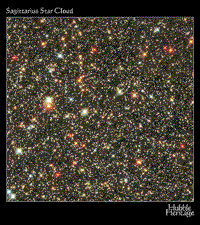
Our galaxy-a part of the Virgo supercluster (containing about 250 large galaxies and up to a 1000 more smaller ones) -probably was born about 9 b.y ago. The closest neighboring spiral galaxy, Andromeda, is located about 225,000 l.y. distant. Much closer are two irregular satellite galaxies - the Large and Small Magellanic clouds - that are about 50 Kpc (16,300 light years) away. All of these galaxies are moving (separating) relative to each other. Spiral galaxies slowly rotate; the Milky Way completes one full revolution about its center in 200 million years.

Collaborators: Code 935
NASA GSFC, GST, USAF
Academy
Contributor Information
Last Updated: September '99
Webmaster: Bill Dickinson Jr.
Site Curator: Nannette Fekete
Please direct any comments to rstweb@gst.com.